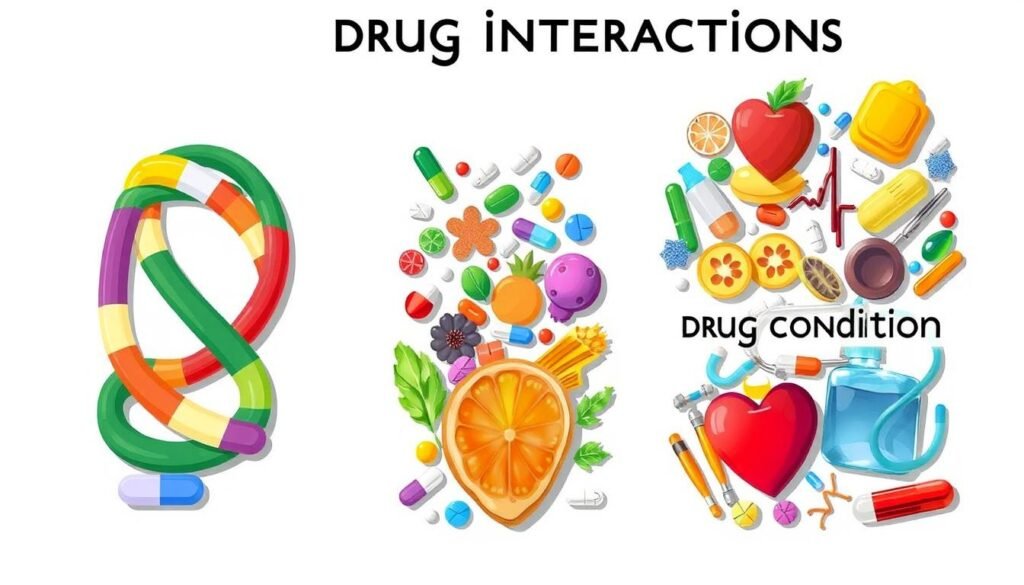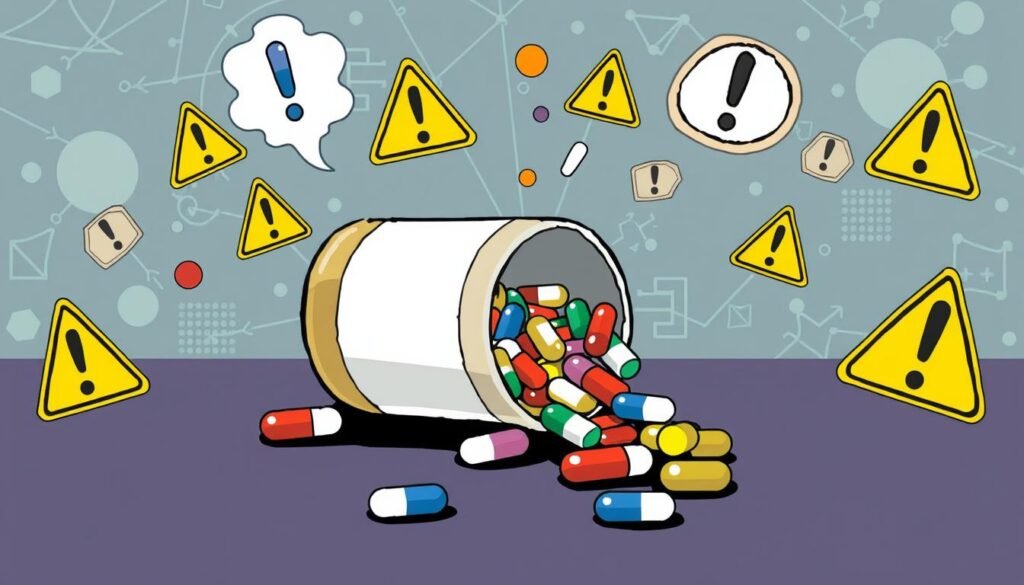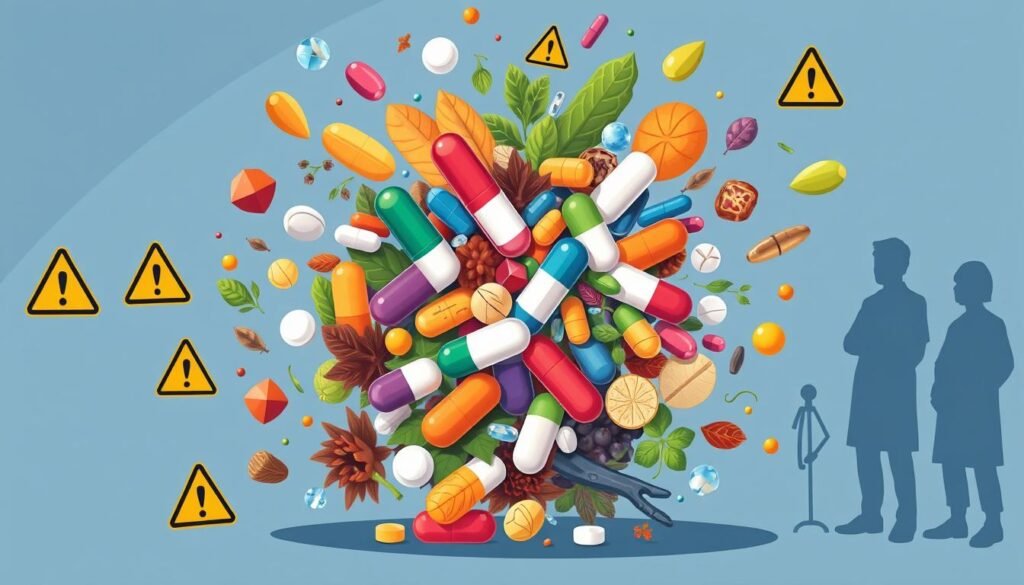Did you know nearly 50% of Americans take prescription drugs? It’s crucial to grasp drug interactions and their risks. Such interactions might lessen a drug’s impact or cause unplanned side effects. These issues can be dangerous, for instance, when using machinery.
Taking a sedative with an antihistamine might slow your reactions, increasing danger. Additionally, pre-existing conditions like high blood pressure can make some treatments unsafe. For example, taking a nasal decongestant could worsen the condition.
With more people, especially seniors, handling various medications, understanding these risks is key. Being well-informed helps in making wise health choices. This can avert negative outcomes and assure treatments are both safe and effective.
Key Takeaways
- Nearly half of Americans are on prescription medications, highlighting the importance of understanding drug interactions.
- Drug interactions can reduce effectiveness or cause severe side effects.
- Patients must disclose all medications, including OTC drugs, to avoid adverse reactions.
- Age and number of medications increase the risk of harmful drug interactions.
- Healthcare providers should regularly update medication lists for their patients.
Understanding Drug Interactions
Drug interactions can happen when you mix medicines with other substances. This affects how your body handles drugs. About 48.6% of Americans used at least one prescription drug last month. Knowing about these interactions helps keep you safe when taking medication. They can make drugs work less well, cause new side effects, or worsen health issues.
These interactions might occur with prescription drugs, over-the-counter meds, or even what you eat. For example, mixing warfarin (Coumadin) with fluconazole (Diflucan) can increase bleeding. Also, ibuprofen can reduce the effectiveness of diuretics. This shows why understanding drug interactions is key for anyone taking multiple medicines.
Some foods, like grapefruit juice, can cause problems with certain statins, leading to liver risk. Drinking alcohol while on drugs like metronidazole can lead to flushing and tummy pain. Knowing how food and alcohol mix with your meds is important for your safety. Also, meds like decongestants can make blood pressure rise, which is bad for high blood pressure patients.
It’s key to understand that everyone is different. Your genes, age, and lifestyle can change how you react to mixed medicines. Knowing how and when to take your meds can help avoid problems. Reading drug labels carefully is also crucial to understand possible risks and stay safe. Drug interactions cause many hospital visits in the U.S. every year and cost lots of money.
Using tech can help find and avoid bad drug mixes. Working with pharmacists, especially with drugs like warfarin, can keep patients safe. Healthcare providers can do better by reviewing all the meds a patient takes together. This helps improve care and reduce risks from drug interactions.
Types of Drug Interactions
There are three main types of drug interactions: drug-drug, drug-food, and drug-condition. Knowing about these helps keep patients safe and ensures medicines work as they should.
Drug-Drug Interactions
Drug-drug interactions happen when medicines affect each other’s function. This can change how well they work. There are two types: pharmacodynamic and pharmacokinetic. Pharmacodynamic ones deal with how drugs’ effects combine, which could be good or bad. Pharmacokinetic ones impact how the body handles drugs, like how fast it processes them, which can raise the risk of side effects.
Drug-Food Interactions
What you eat or drink can impact your medicine’s effectiveness. This is called a drug-food interaction. For example, grapefruit juice can affect how certain medicines, like statins, are processed by your body, leading to more side effects. Knowing about these can help you manage your diet and medication together.
Drug-Condition Interactions
Some medicines can make certain health conditions worse. This is known as a drug-condition interaction. For instance, some antihistamines may worsen breathing problems. Similarly, decongestants might raise blood pressure in people with hypertension. It’s important to choose medicines carefully to ensure they don’t harm.

| Type of Interaction | Description | Examples |
|---|---|---|
| Drug-Drug Interactions | Effects when multiple medications influence each other. | Warfarin with fluconazole; antidepressants and opioids. |
| Drug-Food Interactions | Changes in medication efficacy due to food or drink. | Grapefruit juice with statins; certain medications with high-fat meals. |
| Drug-Condition Interactions | Worsening of medical conditions through medication use. | Decongestants in hypertensive patients; NSAIDs in individuals with kidney disease. |
Recognizing Potential Risks
Figuring out drug interaction risks is key for patient safety. People use many medicines and supplements together, which can cause problems. Pharmacists help by finding these issues to make sure treatments work well. St. John’s Wort or Ginkgo biloba may mess with how other drugs work. This can make them less effective or more toxic.
It’s important to understand how drugs mix inside the body. Pharmacokinetic interactions affect a drug’s journey through absorption, distribution, metabolism, and excretion. An herbal supplement might speed up or slow down how drugs are broken down in the liver. This increases the chance of side effects. Pharmacodynamic interactions might change the effect drugs have on the body, leading to different outcomes.
People should read drug labels and talk to health experts about all their medicines. Talking about drug interaction risks helps doctors make better choices. Understanding risks, like with lung cancer, helps shape better treatments. Anyone can learn more about risk management by checking out best practices in risk assessment.
Many have tried complementary and alternative medicines (CAM), yet the risks often go unnoticed. It takes teamwork between pharmacists, healthcare workers, and patients to handle drug interactions safely.

| Herbal Medication | Potential Drug Interaction | Known Side Effects |
|---|---|---|
| Echinacea | May affect immune modulation | Allergic reactions, gastrointestinal upset |
| St. John’s Wort | Reduces effectiveness of antidepressants | Photosensitivity, gastrointestinal issues |
| Ginkgo biloba | Increased bleeding risk with anticoagulants | Headaches, dizziness, allergic skin reactions |
| Garlic | May enhance effects of anticoagulants | Heartburn, gastrointestinal upset |
Interactions with Conventional Treatments and Potential Risks
It’s very important to understand how regular treatments and other medicines interact. As people get older, they often use everyday drugs to stay healthy. But when they also use alternative medicines, the risk of negative reactions goes up. It’s key to talk openly with doctors to avoid these dangers.
Overview of Risks with Common Medications
Combining usual drugs with some alternative remedies can be risky. Research shows that older adults, especially those above 75, are at high risk. This is because they tend to take many medicines. For example, mixing things like ginkgo, garlic, or ginseng with blood thinners can cause serious bleeding issues. Here’s a table that shows these risky combinations:
| Complementary Product | Conventional Medication | Risk Level |
|---|---|---|
| Ginkgo | Aspirin | High |
| Garlic | Warfarin | High |
| Ginseng | Ticlopidine | Moderate |
| Ginkgo | Pentoxifylline | Moderate |
Importance of Disclosures to Healthcare Providers
It’s crucial for patients to tell their doctors about all drugs and supplements they’re taking. Not doing so can mess up their care plans and up the risk of problems. Ninety percent of study participants use prescription drugs, and many also take vitamins or over-the-counter (OTC) products. Doctors must know about these to manage health safely. Talking about all medicines regularly helps improve care and keeps patients safe from bad drug reactions.

Side Effects and Adverse Reactions
Side effects and adverse reactions can come from mixing different medicines. They can range from slight discomfort to serious health problems. It’s very important to know about medication safety. This knowledge helps patients tell when they need urgent medical help.
It’s good for patients to know what their medicines might do. Especially how they react with other drugs or food. Talking to doctors about all drugs, including vitamins and non-prescription medicines, is vital. It helps lower the chance of side effects. Using non-standard treatments needs careful thought about their effects with other medicines.
| Type of Reaction | Mild Symptoms | Severe Symptoms |
|---|---|---|
| Nausea | Common initial reaction to many medications | May lead to dehydration if persistent |
| Fatigue | Often associated with chemotherapy treatments | Can significantly impact quality of life |
| Allergic Reactions | Rashes or mild itching | Anaphylaxis, requiring emergency treatment |
| Drug-Drug Interactions | Reduced efficacy of medications | Life-threatening situations, such as bleeding or organ failure |
| Herbal Interactions | Mild gastrointestinal disturbances | Increased risk of serious health issues, such as spontaneous bleeding |
Keeping a close eye on how drugs work together is key to safe health care. Doctors can help by making sure patients are well-informed. This ensures treatments are safe and effective. For more info, check out the FDA’s comprehensive guide.
Safety Concerns with Over-the-Counter Medications
Many people don’t see how risky over-the-counter (OTC) meds can be. The increase in OTC meds being made available is worrying. It shows we need to really understand the risks of OTC meds.
Common OTC Medications and Their Risks
OTC meds like ibuprofen and acetaminophen are handy but can be unsafe. Here are some risks:
- Interactions with prescription medications: Mixing OTC drugs with prescription ones can lead to unwanted side effects or less effectiveness.
- Overdose potential: It’s easy to get confused about how much to take without clear instructions.
- Incomplete information: People often forget that herbal supplements can also cause problems and affect regular meds badly.
Reading Drug Labels Effectively
Reading drug labels right is key to using OTC meds safely. Labels tell you about:
- Active ingredients and how much of them there is.
- How to take the meds, including how much to use.
- Warnings about what not to do and possible bad reactions.
Knowing these things helps people make safe choices. Being aware cuts down on the common dangers. Wrong use of OTC meds can cause bad reactions. But, this can be prevented by making informed decisions.
| OTC Medication | Common Risks | Recommendation |
|---|---|---|
| Ibuprofen | Stomach bleeding, kidney damage | Take with food; consult with a doctor if on other medications. |
| Acetaminophen | Liver damage, overdose risk | Do not exceed recommended dosage; check for combination products. |
| Cold Remedies (e.g., dextromethorphan) | High blood pressure, heart rate changes | Monitor blood pressure if taking other medications. |
Risk Management Strategies
Good risk management helps us deal with drug interactions and safety in treatment. Talking to healthcare professionals is key. By discussing all medicines, including vitamins and over-the-counter drugs, we can avoid bad reactions. Healthcare workers give personalized advice to prevent risky drug combinations and offer safer alternatives.
Consulting Healthcare Professionals
Talking to healthcare professionals often improves risk management. Meeting with doctors, pharmacists, and specialists gives a full review of treatment plans. Such communication spots possible drug interactions early, making treatments safer.
Maintaining an Updated Medication List
Keeping an up-to-date medication list is vital for managing risks well. This list should include all medicines, over-the-counter items, and supplements. A complete and recent list helps in discussing drug interactions with healthcare providers. It makes sure treatments are reviewed thoroughly. Organizations use tools for compliance and risk checking. These tools stress the need for keeping medication lists current. To learn more about tools that help with risk management, check out this overview of risk management.
Complementary Therapies and Conventional Medicine
Understanding how complementary therapies and conventional medicine work together is key. An integrative approach combines them to improve health. Therapies like acupuncture, yoga, and meditation are proven to add value to standard treatments.
Yet, careful consideration is needed with complementary therapies. Herbal supplements can be risky. For example, kava kava may harm the liver and St. John’s Wort can interfere with cancer drugs. This shows why talking openly with healthcare providers about using these alternatives is crucial.
Recent research sheds light on complementary therapies’ benefits when used with conventional medicine. A 2020 study found about two-thirds of fibromyalgia patients used alternative medicine. They mainly chose acupuncture and supplements.
Integrative health experts work with traditional healthcare teams to create comprehensive care plans. These plans aim to improve both physical and mental health. It’s vital for patients to discuss any complementary therapies with their doctors. This ensures treatments are safe, effective, and won’t conflict with existing care.
| Complementary Therapy | Safety and Efficacy | Potential Risks |
|---|---|---|
| Acupuncture | Effective for pain relief and cancer-related fatigue | Risk of infection if not performed by a trained professional |
| Yoga | Enhances flexibility and reduces stress | Possible injury if postures are performed incorrectly |
| Meditation | Improves mental clarity and emotional health | May cause discomfort for individuals with certain psychological issues |
| Herbal Supplements | Varies widely, needs professional guidance | Interactions with medications, potential for harmful side effects |
In conclusion, integrating complementary therapies with standard medical treatments can greatly benefit health strategies. Consulting healthcare providers is key to a safe, effective plan that covers all health aspects.
Conclusion
Knowing how drugs work together is key to managing health well. Many cancer patients, about 56%, try complementary medicine after diagnosis. They hope it will improve their treatment, but often they’re unsure about the risks. It’s very important to talk openly with doctors about using these supplements with regular treatments.
Research points out that 45% of patients include complementary medicine in their treatment. Yet, not every mix of these therapies is safe. While 40% might not cause drug interactions, there’s a risk for the rest. This fact shows why we must keep learning and asking questions about our treatment options. Making clear, informed choices helps us take care of our health.
Using complementary therapies wisely can make health outcomes better. Patients should always be in the loop and talk with their healthcare teams. This way, they can avoid risks and get the most out of their treatment as they fight towards getting better.